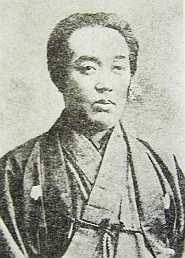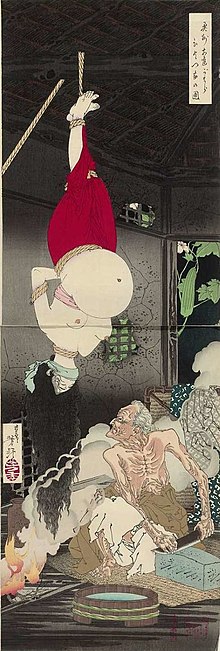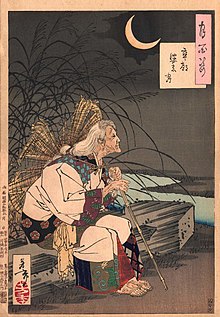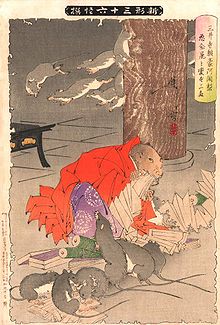Tsukioka Yoshitoshi

Tsukioka Yoshitoshi ( Japanese 月 岡 芳 年 ; * 1839 in Edo ; † June 9, 1892 ; later Taiso Yoshitoshi 大 蘇 芳 年 ) was one of the last great masters and one of the great innovative and creative spirits of classic Japanese woodblock prints , especially of ukiyo -e .
Yoshitoshi's work extended from the last years of feudal Japan to the early years of modern Japan. Like many other Japanese, he was interested in things and developments from the rest of the world, but over time he became increasingly concerned about the loss of Japanese traditions, which included the classic woodblock print.
While working in the traditional way, Japan adopted Western methods of mass reproduction such as photography and lithography . In the course of his career, Yoshitoshi managed to raise the traditional Japanese woodblock print to a new level almost single-handedly, before he actually ceased to exist with it.
Yoshitoshi's meaning was characterized by John Stevenson as follows:
- "Yoshitoshi's courage, foresight and strength of character breathed life into Ukiyo-e for another generation and illuminated it with a final burst of glory."
Life
Yoshitoshi was born in Edo (now Tokyo ) in 1839 under the name Owariya Yonejirō . His father was a wealthy trader who bought samurai status . After he had taken a new partner, Yoshitoshi lived from the age of three with his uncle, a pharmacist without children of his own.
Owariya Yonejirō got his stage name Yoshitoshi from his master Utagawa Kuniyoshi , one of the last great masters of Japanese woodblock printing, whose apprentice he became in 1850 at the age of 11. One of his fellow apprentices was Yoshiiku , who allegedly bullied and bullied the younger Yoshitoshi; the rivalry and enmity between the two artists continued in later years. Although he was not regarded as the successor to Kuniyoshi during his lifetime, Yoshitoshi is now regarded as his main student.
Yoshitoshi's first print appeared in 1853 when he was fourteen years old: a triptych of the sea battle of Dan-no-ura , in which the Minamoto clan defeated the forces of the then ruling Taira clan in 1185 . In the same year the US commander Matthew Perry arrived in Japan with the " black ships " and forced the country to open up to the west. After that, Yoshitoshi did not publish anything for some time, perhaps because of an illness in his master's last years. Although his life became difficult after the death of his master Kuniyoshi in 1861, he managed to publish some works; 44 of his prints date from 1862.
Yoshitoshi's early work shows extreme depictions of violence and death, perhaps a reflection of the general lawlessness and violence of a country that simultaneously witnessed the collapse of the Tokugawa shogunate and the forced influence of the West. In addition to political instability, the Japanese economy was also in a deep recession, accompanied by hyperinflation and crop failures. Yoshitoshi happened to be an eyewitness to the Battle of Ueno in 1868. Immediately thereafter, he created several woodblock prints with extremely bloody and cruel scenes, often against a black background. These woodblock prints sold well, and it was during this time that he became known; as early as 1869 he was regarded as one of the best block printing artists in Japan.
From the beginning of the 1870s he did not receive any more commissions, perhaps because the audience was tired of his scenes of violence. In 1871 he became severely depressed and his life spiraled out of control, something that would repeat itself several times before his death. He lived in very poor conditions with his lover Okoto, who sold her clothes and belongings to support him. At one point they even had to use the floor of the house as fuel.
Yoshitoshi's luck turned in 1873 when his mood improved and he became more productive again. As a sign of his improved circumstances, he changed his family name to "Taiso" (大 蘇, great resurrection ). As part of the modernization of Japan, the first newspapers were created and Yoshitoshi was hired to design prints for one of them. His financial situation was still strained, however, and in 1876 his mistress sold herself to a brothel to help him in a typically Japanese gesture of loyalty.
With the Satsuma Rebellion of 1877, when the old feudal order made the last attempt to undo the innovations of the Meiji period , newspaper sales began to rise sharply and woodblock printers were in great demand, especially Yoshitoshi. The color woodblock prints served to illustrate what happened during the rebellion. His prints earned him public recognition and stabilized his finances somewhat.
At the end of 1877 he took a new lover, the geisha Oraku; like Okotu, she also sold her clothes and property, and when they parted after a year she too went to the brothel.
At this point the woodcut industry was in great trouble. All the great artists from the first half of the century, such as Hiroshige , Kunisada, and Kuniyoshi , had died. In the turmoil of modernizing Japan, the woodcut was a dying art. However, Yoshitoshi insisted on high production standards and thereby helped to temporarily keep it from deterioration.
In 1880 Yoshitoshi met Sakamaki Taiko, a former geisha with two children. They married in 1884, and while he continued to have extramarital relationships, it seems that their gentle and patient demeanor helped stabilize him. He now owned a large house and taught many students. In 1882 he was permanently employed by a newspaper publisher, his finances were now secure.
His last years are among his most productive, with the large series One Hundred Views of the Moon (1885-1892) and New Forms of 36 Ghosts (1889-1892), as well as some triptychs of Kabuki actors and scenes. These publications appeared one by one, and the Hundred Views of the Moon in particular were so successful from the start that long lines of buyers formed for each new sheet. During this time he also worked with a friend, actor Ichikawa Danjūrō IX , and others in an attempt to save some of the Japanese arts.
Towards the end of Yoshitoshi's life, his mental health problems returned. When he invited friends to meet with artists in early 1891, it turned out that they did not exist and that the event was based on a delusion. The symptoms worsened and he was sent to a mental hospital. He left this in May 1892, but did not return to his house, but rented rooms elsewhere. There he died three weeks later on June 9, 1892 of a cerebral haemorrhage.
- The night holds back
- with its increasing shine
- the summer moon
- - Yoshitoshi's death poem
Retrospective
Yoshitoshi produced many print series and a large number of triptychs , many of which are of high quality. Two of his most famous series, One Hundred Views of the Moon and 36 Ghosts , contain numerous masterpieces. The third, thirty-two views of customs and manners , was considered the most valuable for many years, but has lost its reputation today. Other lesser-known series also have many good prints, such as Famous Generals of Japan , A Collection of Desires , New Picks of Eastern Brocade Images, and Lives of Modern People .
While his prints remained in demand for several years after his death, interest in them eventually waned. Academic opinion of the time claimed that the Hiroshige generation had indeed been the last generation of great masters of color woodblock printing, and more traditional collectors only collected earlier works, ending with the Utamaro and Toyokuni generation .
Interest in Yoshitoshi reappeared in the 1970s, and reconsideration of his works took in their quality, originality, and ingenuity, and the degree to which he managed to retain the best of the old color woodblock print while simultaneously increasing the range of representations expanded by incorporating new ideas from the West as well as its own innovations.
Since then, Yoshitoshi's reputation in Japan and the West has increased again, and he is now widely regarded as the greatest Japanese artist of his time.
Print series
Incomplete list of Yoshitoshi's print series:
- A hundred ghost stories from Japan and China (1865–1866)
- Biographies of Modern Men (1865–1866)
- 28 famous murderers with verse (1866-1869)
- Hundred Warriors (1868-1869)
- Biographies of drunken brave tigers (1874)
- Mirror of the beauties of the past and present (1876)
- Famous generals of Japan (1876-1882)
- A Collection of Desires (1877)
- Eight Elements of Honor (1878)
- 24 hours with the courtiers of Shimbashi and Yanagibashi (1880)
- Warrior trembling with courage (1883–1886)
- Hundred Views of the Moon (1885-1892)
- Contemporary personalities (1886–1888)
- 32 Views of Uses and Manners (1888)
- New forms of 36 spirits (1889-1892)
literature
- T. Liberthson: Divine Dementia: The Woodblock Prints of Yoshitoshi , Washington, 1981 (English)
- John Stevenson: Yoshitoshi's Thirty-Six Ghosts , New York, 1983 (English)
- Shinichi Segi: Yoshitoshi: The Splendid Decadent , Tokyo, 1985 (English)
- John Stevenson: Yoshitoshi's Women: The Print Series 'Fuzoku Sanjuniso' , Avery Press, 1986 (English)
- John Stevenson: Yoshitoshi's One Hundred Aspects of the Moon , Redmond, 1992 (English)
- Eric van den Ing, Robert Schaap: Beauty and Violence: Japanese Prints by Yoshitoshi 1839–1892 , Eindhoven, 1992 (standard work, English)
Individual evidence
- ↑ John Stevenson: Yoshitoshi's One Hundred Aspects of the Moon (1992)
- ↑ Freely translated from John Stevenson: Yoshitoshi's One Hundred Aspects of the Moon , p. 49
Web links
- Literature by and about Tsukioka Yoshitoshi in the catalog of the German National Library
- Online exhibition on Yoshitoshi at the Fitzwilliam Museum (English)
- Tsukioka Yoshitoshi - extensive website on person and work
| personal data | |
|---|---|
| SURNAME | Tsukioka, Yoshitoshi |
| ALTERNATIVE NAMES | Taiso, Yoshitoshi; Yoshitoshi |
| BRIEF DESCRIPTION | Japanese grand master of Japanese woodblock prints |
| DATE OF BIRTH | 1839 |
| PLACE OF BIRTH | Edo |
| DATE OF DEATH | June 9, 1892 |



